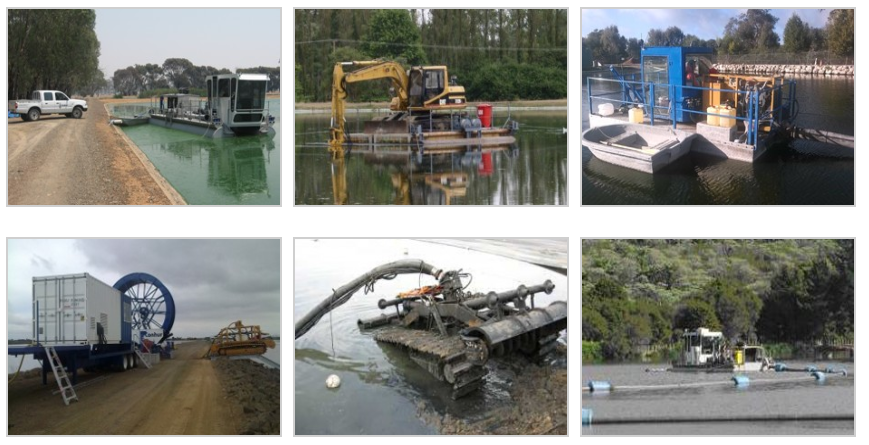CONHUR SOLUTIONS - DREDGING

WHAT IS DREDGING?
Sludge dredging in wastewater treatment ponds involves the removal of accumulated organic and inorganic material, known as sludge or biosolids, from the bottom of ponds used in the treatment of wastewater. Over time, these ponds collect various forms of waste, including solid particles, organic matter, and other sediments, which settle at the bottom and form a thick sludge layer. This accumulation reduces the pond’s treatment capacity, decreases efficiency, and can pose environmental and operational challenges.
The process of sludge dredging (de-sludging) in wastewater treatment ponds typically involves the following steps:
- Assessment: Evaluating the extent and composition of the sludge accumulation through a sludge survey to determine the volume of sludge and the most effective dredging approach/equipment.
- Preparation: Setting up necessary equipment and planning logistics, including the placement of pipelines and disposal areas.
- Dredging: Using specialized dredging equipment, such as an auger-suction dredge, to remove the sludge from the pond bed. The dredge uplifts sludge from the pond floor and pumps to our sludge dewatering plant.
- Dewatering and Disposal: The dredged biosolids are typically ‘preconditioned, thickened and ultimately dewatering in one or multiple centrifuges. The process of centrifuging is very effective at separating water from the dredged material. This is important for two reasons. First the sludge needs to be sufficiently dewatered to allow it to meet the disposal requirements and regulations. Secondly removing water and thus reducing the volume results in significant financial savings when paying for disposal.
Sludge dredging in wastewater treatment ponds is crucial for maintaining the efficiency and effectiveness of the wastewater treatment process. It helps restore the pond’s capacity, ensures optimal treatment of incoming wastewater, and prevents issues such as odour, overflows, and decreased water quality. Regular dredging also extends the lifespan of the treatment pond and contributes to overall environmental protection by preventing the potential release of untreated or poorly treated wastewater into surrounding ecosystems.
WHY WE OFFER DREDGING?
We offer sludge dredging services for wastewater treatment ponds to ensure the efficiency and longevity of these facilities. Dredging maintains the original capacity of ponds by removing accumulated sludge, dead vegetation, and pollutants. This minimises the carry over of suspended solids and environmental contamination by restoring the pond's depth. Additionally, dredging eliminates stagnant water and foul odours, resulting in a healthier and more effective treatment process.
Dredging also prepares ponds for continued use and improves their efficiency by performing necessary sludge removal. It removes stagnant sections of sludge in the pond, improving water circulation in the ponds for better performance. Conhur also ensures sludge is handled and disposed of in an environmentally safe manner. Moreover, dredging prevents sludge contamination in connected waterways, maintaining the overall efficiency of the wastewater treatment process.
ENVIRONMENTAL
- Improved Water Quality:
- Contaminant Removal: Sludge often contains harmful contaminants, including heavy metals, chemicals, and pathogens. Removing sludge from wastewater treatment ponds helps reduce these contaminants, improving the overall water quality.
- Reduced Eutrophication: Eutrophication, caused by excessive nutrients like nitrogen and phosphorus in water, leads to algal blooms and oxygen depletion. Sludge removal reduces nutrient levels, thereby mitigating eutrophication and helping to restore a balanced aquatic ecosystem.
- Enhanced Efficiency of Treatment Processes:
- Increased Treatment Capacity: Removing sludge restores the pond's capacity, allowing it to handle more wastewater and function more efficiently. This enhances the overall effectiveness of the treatment process, ensuring that more water is treated to a higher standard.
- Prevention of Blockages: Sludge buildup can clog equipment and hinder water flow, reducing the efficiency of the treatment process. Dredging removes these obstructions, facilitating smoother operation and better water treatment outcomes.
- Prevention of Environmental Contamination:
- Reduced Risk of Overflows: Excessive sludge can lead to pond overflows, resulting in the discharge of untreated or partially treated wastewater into the surrounding environment. Sludge removal helps maintain adequate pond capacity, preventing such overflows and protecting local waterways from contamination.
- Controlled Disposal: Properly dredged sludge can be treated and disposed of in a controlled manner, reducing the risk of environmental pollution.
- Odour Control:
- Elimination of Foul Odors: Sludge accumulation in ponds often leads to unpleasant odours due to the decomposition of organic matter. Removing sludge helps eliminate these odours, improving the quality of life for nearby communities and reducing the environmental impact of the wastewater treatment facility.
- Support for Regulatory Compliance:
- Meeting Environmental Standards: Regular sludge removal helps wastewater treatment facilities comply with environmental regulations and standards. This ensures that the treated water released into the environment meets the required quality levels, protecting public health and the environment.
- Minimised Soil and Water Contamination:
- Proper Management of Heavy Metals and Toxins: Sludge often contains heavy metals and other toxins that can leach into the soil and water if not properly managed. Removing and treating sludge minimises the risk of these contaminants spreading, protecting soil and water quality.
For all your dredging needs, trust CONHUR SOLUTIONS.
Contact us today to learn more about our dredging services and how we can help you with your next project.
Our experienced team is ready to provide efficient and reliable dredging solutions tailored to your specific requirements.
Don't hesitate to reach out and discover how CONHUR SOLUTIONS can make a difference for you.
Conhur has a range of specialised dredging, pumping and ancillary equipment available.
